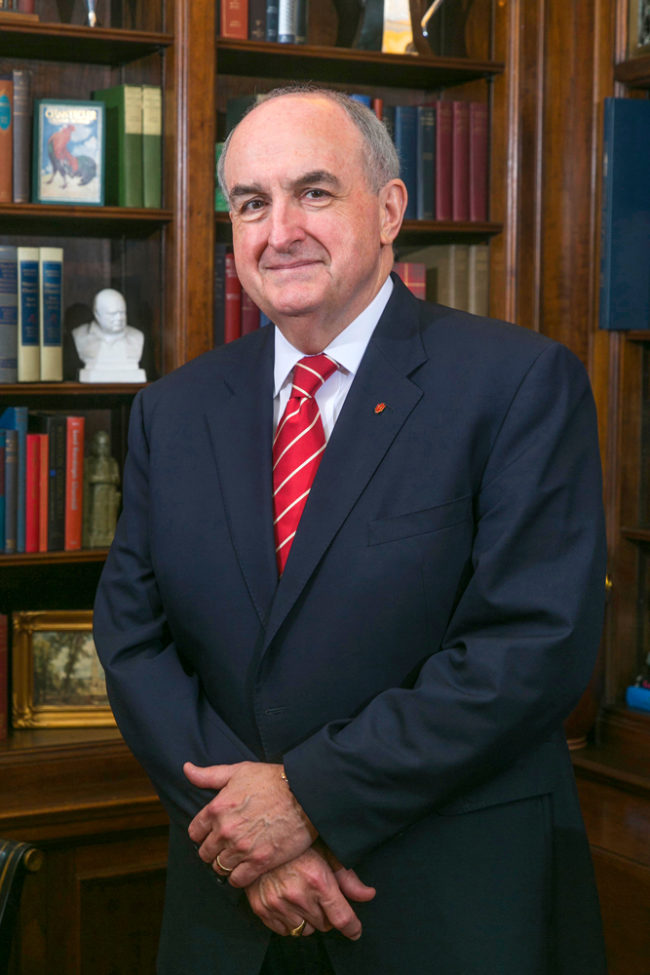
by JAMES CAPSHEW
Indiana University Historian
Legacies are created when extraordinary individual care meets an essential social need. Education is built on them: Who can forget a teacher that sparked your young mind? A gift from the present to the future, legacies can be properly assessed only after time has passed. But the retirement of Indiana University President Michael A. McRobbie after 14 years at the helm provokes curiosity about the potential shape of his legacy.
Universities are learning environments, designed to enhance the breadth and depth of interactions among students and teachers. Although most college presidents spend little time in the classroom, the best of them retain a relentless focus on the pedagogical relationships that lie at its heart. McRobbie generated a staggering array of contributions to Indiana University. Possessed of a percipient and probing mind, coupled with an entrenched personal reserve, he found his calling at Indiana’s original state university, far away from his native Australia.
Hired by IU president Myles Brand in 1997 as vice president for information technology, McRobbie’s administrative skills soon became evident as an innovative plan transformed the university’s cyber infrastructure, leading the university to national leadership in the application of digital technologies to higher education. McRobbie’s planning and management talents became harnessed to an increasingly wide set of responsibilities until the board of trustees appointed him as president in 2007.
McRobbie never wavered from his goal of academic excellence for Indiana University. He supervised improvements to its organizational and financial structure, physical plant, and international connections that reinvigorated IU’s core mission of education and research. His administrative style was to identify an institutional issue or problem, appoint a competent task force, refine measurable indicators of progress, and implement an action plan with sufficient resources. At first, some grumbled at his approach or the pace of change, but he won over most critics.
The McRobbie administration paid enormous attention to IU’s physical facilities and infrastructure, starting with new campus master plans for Bloomington and Indianapolis. An agreement with the Indiana Legislature to restore funds for repair and rehabilitation, provided that IU would fund new construction, broke a gigantic $1 billion logjam of deferred maintenance. “Under construction” signs were ubiquitous at each of the nine statewide campuses. In an audacious move, McRobbie located a regional health center on the flagship campus, containing a new IU Health Bloomington Hospital and a health sciences building for training students.
Revision of the curriculum and renovation of research management was high on McRobbie’s agenda, resulting in an extensive academic restructuring, with 10 new or reconfigured schools and nearly 600 new degree and certificate programs. The innovative Grand Challenges program was started, designed to address formidable social challenges in the Hoosier state by interdisciplinary project-based research efforts.
In the face of declining state appropriations, IU launched a massive fundraiser for all campuses—For All: The Indiana University Bicentennial Campaign—that garnered $3.9 billion in private support from over 300,000 donors. On the national scene, McRobbie chaired the board of directors of the venerable American Association of Universities, composed of 66 leading institutions. In the international arena, he led the renewal of partnerships with nearly 200 foreign universities for joint programs, and strongly supported undergraduate study abroad opportunities.
Deeply concerned about IU’s institutional ethos and community culture, McRobbie launched a public humanities program as the bicentennial approached. A wide-ranging exploration of IU’s history and heritage—“the good, the bad, and the ugly,” the president advised— culminated in a celebration of its 200th anniversary in 2020. Last spring, national calls for racial justice combined with local concerns led the university to reaffirm commitments to diversity and equity as well as to the investigation and removal of campus building names that failed to reflect university values. When the bicentennial was eclipsed by the global pandemic, McRobbie pivoted and mobilized IU’s public health capacity.
IU has been led by 18 presidents, with terms ranging from one to 35 years. McRobbie joins a distinguished group of five presidents with tenures of a decade or more—Andrew Wylie, Cyrus Nutt, William Lowe Bryan, Herman B Wells, and John W. Ryan—who shaped the university we know today. As Indiana University confronts the challenges of its third century, McRobbie has earned our collective gratitude for strengthening its foundations and thus enabling greater heights of service to society.












